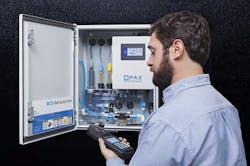Walnut Valley Water District spans a 29-sq-mile area in semi‐arid Southern California, approximately 20 miles east of Los Angeles. Planning for growth amid periodic droughts is difficult, and Walnut Valley’s challenge is compounded by its need to deliver high-quality water to more than 100,000 people via more than 26,000 service connections.
The Problem
Walnut Valley relies primarily on imported water from wholesalers, and it manages that chloraminated supply with the aid of 28 water storage tanks located throughout the service area. While monochloramine provides excellent disinfectant persistence and a decreased risk for trihalomethane production when compared to free chlorine, it naturally decomposes and generates ammonia. Ammonia becomes a food source for naturally occurring ammonia/nitrite-oxidizing bacteria (AOB/NOB) and can ultimately lead to nitrification. Aware of this risk, Walnut Valley aggressively pursued operational strategies in its water storage tanks to limit nitrification risk.
These strategies included deep-tank cycling to fill tanks with “fresh” water to counteract water aging that might lead to further chloramine decomposition, as well as limiting actual water storage. For example, some 30-ft tanks were routinely only filled to the 6-ft level. Additionally, as conditions worsened in the warmer summer months, operators often would valve off tanks and carry out breakpoint chlorination to impact AOB/NOB growth to prevent nitrification. As a final option, tanks could be drained and cleaned.
The Solution
Walnut Valley had used tank mixing in the past and saw incremental improvements. In 2016, the staff decided to install an automated residual control system (RCS) to manage disinfectant levels in a cluster of three 4-to-5-million-gal tanks (Ridgeline tanks). The PAX Monoclor RCS was installed in December 2016 by D&H Water and was comprised of PAX tank mixers; water quality stations that monitor oxidation reduction potential, total chlorine and pH; ammonia feed systems; hypochlorite feed systems; and “smart” controllers that dose the right amount of ammonia or chlorine based on the need of the individual tanks. All the control and tank analytics were tied into the Walnut Valley SCADA system for real‐time review.
Immediately, the Monoclor system asserted control over the residual levels and brought the tanks to a consistent 2.3-ppm residual level.
The Results
With the implementation of the PAX Monoclor RCS, Walnut Valley was able to reduce the nitrite (nitrification precursor) levels, as well as improve residual levels in the service area. The elimination of energy-intensive deep-tank cycling was a bonus, as was the elimination of the labor-intensive practice of breakpoint chlorination.



